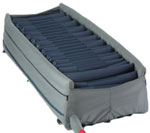Replacement Bed Mattress Systems
Replacement mattresses are complete mattress systems designed to replace the existing mattress on a bed and can be used on box spring, spring or solid pan beds.
Click here for detailed Mattress Overlay Information.
Mattresses | |
Standard hospital bed mattressesStandard hospital bed mattresses are probably pretty rare these days. They were normally pretty basic spring mattresses with a cover made out of a waterproof, washable plastic/vinyl like material. Anyone who has ever spent any time on one, will be able to easily explain why they are pretty rare now. |

|
Foam hospital bed mattressesFoam hospital bed mattresses are what are considered normal hospital bed mattresses today. They come in a variety of different qualities of foam and tend to be a hybrid of the low end foam and the true memory foam. They have more vinyl like covers which are still waterproof and washable but are softer to the touch than the old style hospital mattresses. |

|
Memory Foam MattressesMemory foam mattresses are available for hospital beds and all the sizes of beds one would find in a person's home. Having the same properties as the memory foam overlays but thicker overall they can be placed on a box spring or directly onto the springs or solid base of a bed. While their covers aren't waterproof, the foam itself is and the covers can be removed and washed in a washing machine when soiled. The pictured Visco foam mattress is available in twin, double and queen sizes. |

|
Low air loss mattressesLow air loss mattresses are today's top level pressure relieving mattresses. They are normally a series of air cells about 8" high by 6" wide by 30" long all connected together by a manifold of air tubing, connected to an air pump and encased in a very soft vinyl like cover. The air pump has an adjustment on it to allow for fine tuning of the pressure in the mattress cells in order to give the best possible pressure relief for the patient. While being very soft and adjustable this type of mattress would not do much to reduce moisture and heat if it weren't for the air loss feature. What the designers of these mattresses have done is put several tiny holes in each cell of the mattress. These holes cause the air to leak out and the pump to work constantly to keep the mattress cells inflated, thus the name low air loss. Because of this constant flow of air, heat and moisture are constantly wicked away from the patients body and the chances of pressure sores are reduced. Most low air loss mattresses have an alternating feature which allows them to work in a similar method as the Alternating pressure pad overlays to prevent pressure sores by constantly changing the pressure points on a person's body. |

|
Turning low air loss mattressesTurning low air loss mattresses are the same as the above two mattresses with the exception they have the capability of gently turning the patient constantly back and forth thus simulating movement by the patient and changing pressure points to prevent pressure sores. There is some control of the speed of the turning action but in general a full cycle will probably take as long as an hour. |

|


 Online Vendors
Online Vendors  US Online Vendors
US Online Vendors 
